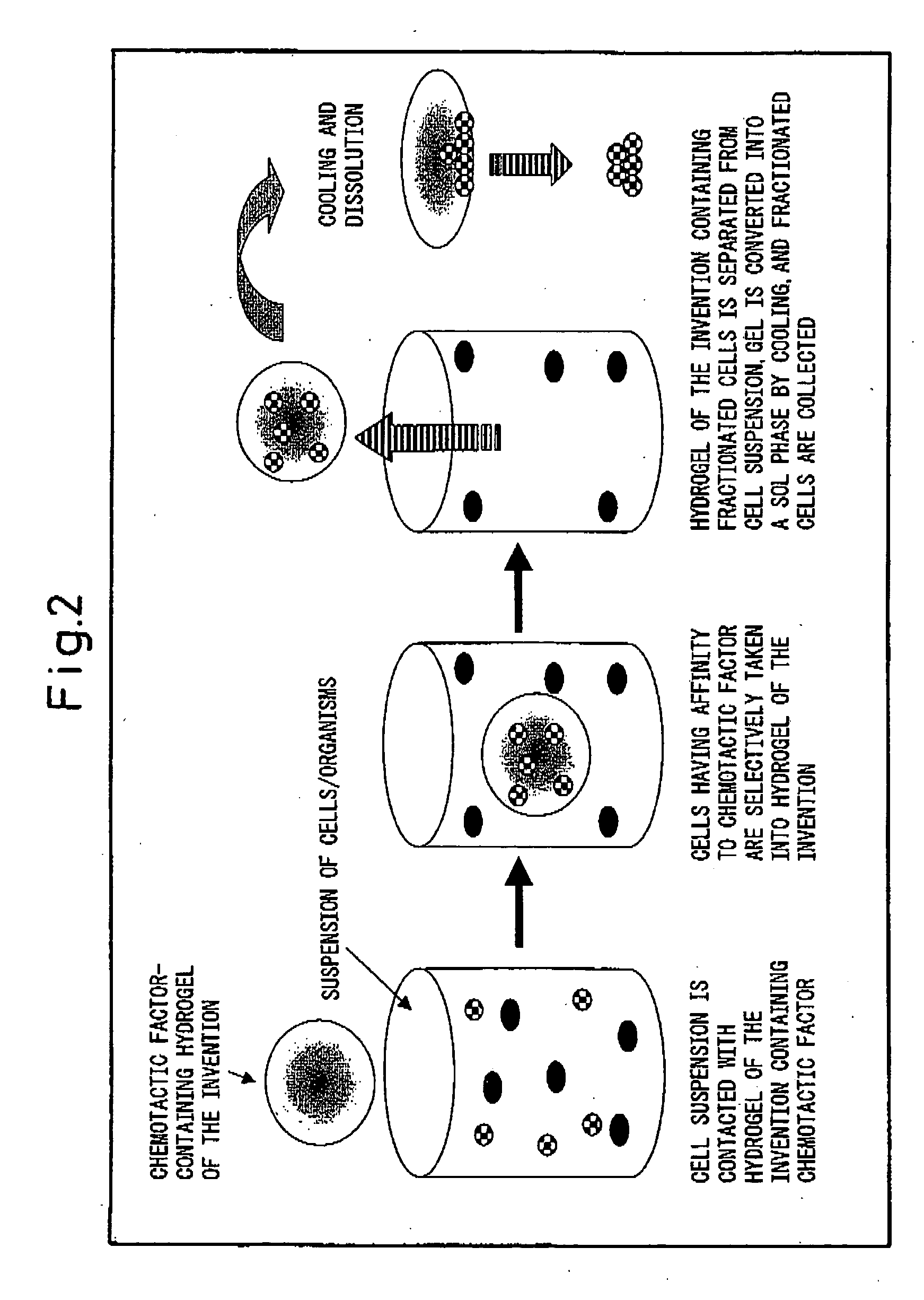Hydrogel for cell separation and method of separating cells
a cell and cell technology, applied in the field of hydrogel for cell separation and cell separation, can solve the problems of increasing the possibility of cancer metastasis, and the fact that it is impossible to achieve the separation of cells/organisms having a variety of taxes, and the effect of differential separation
- Summary
- Abstract
- Description
- Claims
- Application Information
AI Technical Summary
Benefits of technology
Problems solved by technology
Method used
Image
Examples
production example 1
[0176] 10 g of a polypropylene oxide-polyethylene oxide copolymer (average polymerization degree of propylene oxide / ethylene oxide=about 60 / 180, Fluronic F-127, mfd. by Asahi Denka K.K.) was dissolved in 30 ml of dry chloroform, and in the co-presence of phosphorus pentaoxide, 0.13 g of hexamethylene diisocyanate was added thereto, and the resultant mixture was subjected to reaction under refluxing at the boiling point for six hours. The solvent was distilled off unde reduced pressure, the resultant residue was dissolved in distilled water, and subjected to ultrafiltration by using an ultrafiltration membrane having a molecular cutoff of 3×104 (Amicon PM-30) so as to fractionate the product into a low-molecular weight polymer fraction and a high-molecular weight polymer fraction. The resultant aqueous solution was frozen, to thereby obtain a high-polymerization degree product of F-127 and a low-polymerization degree product of F-127.
[0177] When the above high-polymerization degree ...
production example 2
[0178] 160 mol of ethylene oxide was subjected to an addition reaction with 1 mol of trimethylol propane by cationic polymerization, to thereby obtain polyethylene oxide triol having an average molecular weight of about 7000.
[0179] 100 g of the thus obtained polyethyleneoxide triol was dissolved in 1000 ml of distilled water, and then 12 g of potassium permanganate was slowly added thereto at room temperature, and the resultant mixture was subjected to an oxidization reaction at this temperature for about one hour. The resultant solid content was removed by filtration, and the product was subjected to extraction with chloroform, and the solvent (chloroform) was distilled off, to thereby obtain 90 g of a polyethylene oxide tricarboxyl derivative.
[0180] 10 g of the thus obtained polyethylene oxide tricarboxyl derivative, and 10 g of polypropylene oxide diamino derivative (average propylene oxide polymerization degree: about 65, trade name: Jeffamine D-4000, mfd. by Jefferson Chemica...
production example 3
[0181] 96 g of N-isopropyl acrylamide (mfd. by Eastman Kodak Co.), 17 g of N-aclyloxy succinimide (mfd. by Kokusan Kagaku K.K.), and 7 g of n-butyl methacrylate (mfd. by Kanto Kagaku K.K.) were dissolved in 4000 ml of chloroform. After the purging with nitrogen gas, 1.5 g of N,N′-azobisisobutyronitrile was added thereto, and the resultant mixture was subjected to polymerization at 60° C. for 6 hours. The reaction mixture was concentrated, and then was reprecipitated in diethyl ether. The resultant solid content was recovered by filtration, and then was dried under vacuum, to thereby obtain 78 g of poly (N-isopropyl acrylamide-co-N-aclyloxy succinimide-co-n-butyl methacrylate).
[0182] Then, an excess of isopropylamine was added to the thus obtained poly(N-isopropyl acrylamide-co-N-aclyloxy succinimide-co-n-butyl methacrylate) to thereby obtain poly(N-isopropyl acrylamide-co-n-butyl methacrylate). The thus obtained poly(N-isopropyl acrylamide-co-n-butyl methacrylate) had a cloud point...
PUM
| Property | Measurement | Unit |
|---|---|---|
| transition temperature | aaaaa | aaaaa |
| transition temperature | aaaaa | aaaaa |
| sol-gel | aaaaa | aaaaa |
Abstract
Description
Claims
Application Information
 Login to View More
Login to View More - R&D
- Intellectual Property
- Life Sciences
- Materials
- Tech Scout
- Unparalleled Data Quality
- Higher Quality Content
- 60% Fewer Hallucinations
Browse by: Latest US Patents, China's latest patents, Technical Efficacy Thesaurus, Application Domain, Technology Topic, Popular Technical Reports.
© 2025 PatSnap. All rights reserved.Legal|Privacy policy|Modern Slavery Act Transparency Statement|Sitemap|About US| Contact US: help@patsnap.com


